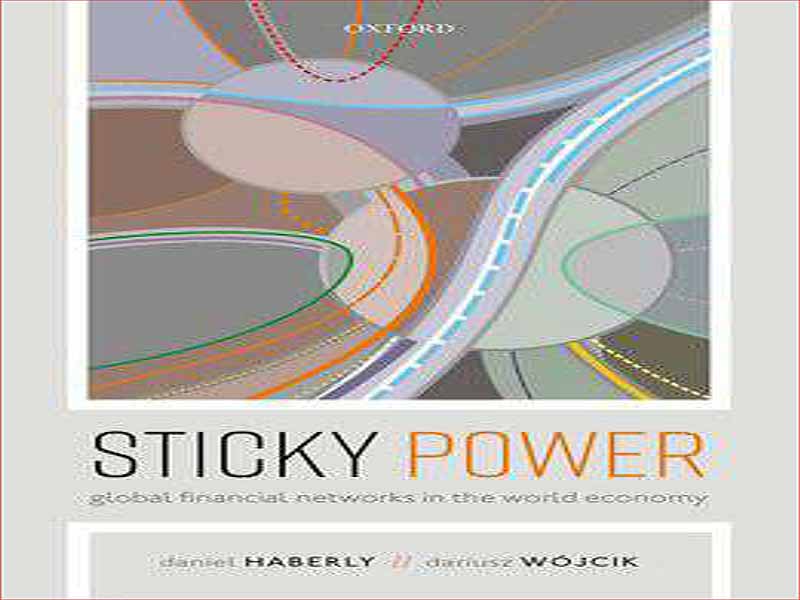- عنوان کتاب: Sticky Power / Global Financial Networks in the World Economy
- نویسنده: Emmanuel D. Farjoun
- حوزه: اقتصاد جهانی
- سال انتشار: 2022
- تعداد صفحه: 411
- زبان اصلی: انگلیسی
- نوع فایل: pdf
- حجم فایل: 19.4 مگابایت
در سال 1922 ویلیام تی فاستر مقاله ای را در American Economic Review در مورد جریان مداری پول منتشر کرد. او می خواست توجه را به ماهیت این جریان ها و اهمیت بالقوه آنها برای درک نوسانات تجاری جلب کند. او پول را ارز و چک کردن سپردهها در جهت مخالف جریان کالا تعریف کرد. برخلاف کالاهایی که با مصرف یا دور ریختن یک کالا از چرخش ناپدید می شوند (به رغم ملاحظات زیست محیطی و انرژی)، پول بی انتها در گردش است. از این رو مفهوم جریان مدار، که فاستر با نموداری از مخازن و خطوط لوله نشان داده است است. با اعتراف خود فاستر، این نقاشی تحت تأثیر مالکوم سی رورتی، که در دانشگاه کرنل مهندسی خوانده بود، مؤسس دفتر ملی تحقیقات اقتصادی، و رئیس انجمن آمار آمریکا بود، قرار گرفت. دادهها برای تعیین کمیت جریانهای مالی در ایالات متحده شروع به در دسترس شدن کردند، و فاستر با مقالهاش به وضوح همکاران اقتصاددان و آماردانهای خود را تشویق میکرد تا از این دادهها و مدل مدار مهندسی خود برای درک بهتر پول استفاده کنند. مهمترین کاربرد برای او مطالعه تأثیرات جریان مدار بر چرخه تجاری و همچنین عوامل بالقوه متعددی بود که می توانند جریان را کاهش دهند، از دستمزدهای کمتر، مالیات های بالاتر و تورم مورد انتظار کمتر (یا کاهش تورم مورد انتظار). به نرخ بالاتر پس انداز و سود انباشته. این مقاله بخشی از کتابی بود که فاستر با همکلاسیاش در هاروارد، Waddill Catchings تالیف کرد و در سال 1923 با سادهترین عنوان ممکن، «پول» منتشر شد. Catchings در آن زمان در وال استریت ثروتمند بود و اولین شریک ارشد گلدمن ساکس از خارج از خانواده گلدمن یا ساکس شد. مهندسی مالی او تقریباً گلدمن ساکس را از طریق ایجاد یک تراست سرمایه گذاری با اهرم بالا به نام شرکت بازرگانی گلدمن ساکس، که پول سرمایه گذاران را برای سرمایه گذاری در سهام جمع می کرد، تقریباً ورشکست کرد، و در پی سقوط بزرگ سال 1929، که در واقع به طور مستقیم به آن کمک کرد، از بین رفت. . همچنین در سال 1929، در سواحل رودخانه فرات در بین النهرین قدیمی (جنوب عراق امروز)، باستان شناس آلمانی، جولیوس جردن، انبار وسیعی از لوح های گلی را از اوروک، یکی از اولین شهرهای بزرگ جهان، کشف کرد. این الواح که به خط انتزاعی معروف به خط میخی نوشته شدهاند، قدیمیترین شکل نوشتاری هستند که تاکنون کشف شدهاند و قدمت آن به حدود 3100 سال قبل از میلاد میرسد. در دهه 1970 بود که باستان شناس فرانسوی دنیز اشمانت-بسرات شروع به کشف این شد که این لوح ها برای چیست. چنانکه پیداست، آنها شعر نبودند، بلکه اسناد معاملات و تعهدات بودند. سوابق آنچه پرداخت شده است و آنچه بدهکار است و باید در آینده پرداخت شود. به این ترتیب، این تبلت ها به طور همزمان اولین حساب ها و قراردادهای قانونی شناخته شده در جهان را نشان می دهند. عمل حسابداری برای معاملات، پرداخت ها و مطالبات، همچنین شامل اولین استفاده شناخته شده از نمادهای انتزاعی برای اعداد، از جمله ارقام بسیار بزرگ بود. برای مثال، یکی از تقاضاها برای غرامت جنگی، 4.5 تریلیون لیتر دانه جو بود که بیش از پانزده برابر تولید سالانه جو امروز در جهان است. به این ترتیب، لوحهای گلی اوروک نشاندهنده یک نوآوری مالی، حسابداری و حقوقی است که در یک نوآوری نیز پیشرفتی در نوشتن و شمارش به همراه داشته است. به گفته تیم هارتفورد، این نوآوریها برای مقابله با شبکهای از تعهدات و برنامههای بلندمدت بین افرادی که به خوبی یکدیگر را نمیشناختند، که شاید حتی هرگز همدیگر را نمیشناختند، توسعه یافتند (2017). از آن زمان به بعد، جامعه به شکل های پیچیده تر با همین مشکل مواجه بوده است.
In 1922 William T. Foster published a paper in the American Economic Review on the circuit flow of money. He wanted to draw attention to the nature of these flows and their potential significance to understanding business fluctuations. He defined money as currency and checking deposits moving in the opposite direction to the flow of goods. In contrast to goods, which disappear from circulation when a good is consumed or disposed of (environmental and energy considerations notwithstanding), money keeps circulating endlessly. Hence the notion of the circuit flow, which Foster illustrated with a diagram made of reservoirs and pipelines. By Foster’s own admission the drawing was influenced by Malcolm C. Rorty, who studied engineering at Cornell University, cofounded the National Bureau of Economic Research, and was the president of the American Statistical Association. Data to quantify financial flows were starting to become available in the USA, and with his paper Foster was clearly encouraging his fellow economists and statisticians to use such data, and his engineering-inspired circuit model, to better understand money. The most important application for him was to study the effects of the circuit flow on the business cycle, as well as multiple potential factors that can slow down the flow, from lower wages, to higher taxes and lower expected inflation (or expected deflation), to higher rate of savings and retained earnings. The paper was part of the book co-authored by Foster with his Harvard classmate Waddill Catchings, which was published in 1923 under the simplest possible title, “Money.” Catchings at that time was making a fortune on Wall Street, becoming the first senior partner at Goldman Sachs from outside of the Goldman or Sachs families. His financial engineering nearly bankrupted Goldman Sachs through the creation of a highly leveraged investment trust called Goldman Sachs Trading Corporation, which pooled investors’ money to invest in stock, and unraveled in the wake of the 1929 great crash, to which it in fact directly contributed. Also in 1929, on the banks of the river Euphrates in erstwhile Mesopotamia (today’s southern Iraq), German archaeologist Julius Jordan unearthed a vast cache of clay tablets from Uruk, one of the world’s first large cities. The tablets, written in an abstract script known as cuneiform, are the oldest form of writing yet discovered, dating from around 3100 BCE. It was not until the 1970s that the French archaeologist Denise Schmandt-Besserat began to figure out what the tablets were for. As it turns out, they were not poetry, but rather records of transactions and obligations; records of what has been paid and what is owed and should be paid in the future. As such, these tablets simultaneously represent the world’s first known accounts and legal contracts. The practice of accounting for transactions, payments and claims, also involved the first known use of abstract symbols for numbers, including stunningly large figures. One demand for war reparations, for example, was for 4.5 trillion liters of barley grain, more than fifteen times the global annual production of barley today. As such, the clay tablets from Uruk represent a financial, accounting, and legal innovation all in one, which also brought with it a breakthrough in writing and counting. These innovations were developed, in the words of Tim Hartford “to deal with a web of obligations and long-range plans between people who did not know each other well, who might perhaps never even meet” (2017). The same problem has faced society ever since, in ever more complex forms.
این کتاب را میتوانید از لینک زیر بصورت رایگان دانلود کنید:
Download: Sticky Power / Global Financial Networks in the World Economy



































نظرات کاربران